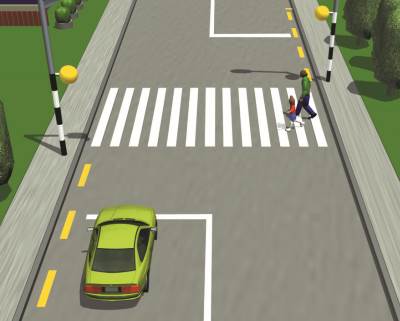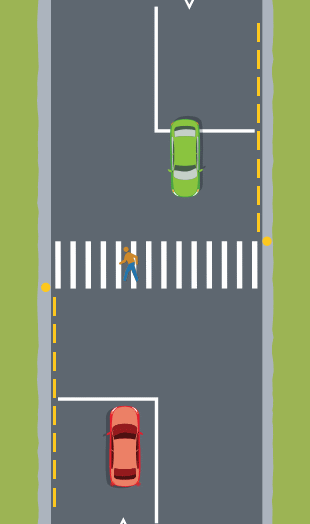A. Continue driving unless the pedestrian is crossing your lane
 When approaching a pedestrian crossing without a raised traffic island, what must you do?
When approaching a pedestrian crossing without a raised traffic island, what must you do?
A. Continue driving unless the pedestrian is crossing your lane
B. Give way to pedestrians on any part of the crossing
C. Honk your horn at the pedestrian

There are several types of pedestrian crossings including raised crossings, courtesy crossings, staggered crossings, crossings at traffic lights, and so on.
On a pedestrian crossing without a raised traffic island you must stop if a pedestrian is on the crossing waiting to cross on your side of the road, is already on the crossing walking towards your side of the road, or is on your lane crossing in front of you.
Crossings with a raised central island: you must stop if a pedestrian is on your half of the crossing, but not if they are on the other half.
Courtesy crossings: you are not obliged to stop, but it is courteous to do so.
Crossings at traffic lights: you must stop if the lights are red, or if there are pedestrians crossing when the lights turn green.
School (kea) crossing: you must stop if the stop signs are moved across the road.
More detailed information about crossings is here.
Pedestrian crossings, which are called zebra crossings in some countries, usually have white stripes painted across the road. The approach to the crossing will often have a white diamond if the crossing is slightly obscured - note that that is different to some other countries which have zigzags or other road markings on the approach. There will also be a diamond-shaped yellow sign with a pedestrian crossing symbol.
There will be two or four poles marking the crossing, painted in black and white with either a solid orange disk or a flashing orange light on the top.
Crossings in busier centres also often have tactile pavement markings to help visually impaired users know where the crossing is.
For a comprehensive guide to pedestrian crossings, click here.
As you approach any crossing, regardless of whether it has a raised traffic or not, scan the pavements at the crossing for pedestrians that look like they are about to step out into the road. Be aware of any obstructions that might obscure your view such as parked trucks, posts and signage.
If you are driving a larger vehicle it can be more difficult for pedestrians to judge your speed and distance than a smaller vehicle.
Older pedestrians could have reduced vision.